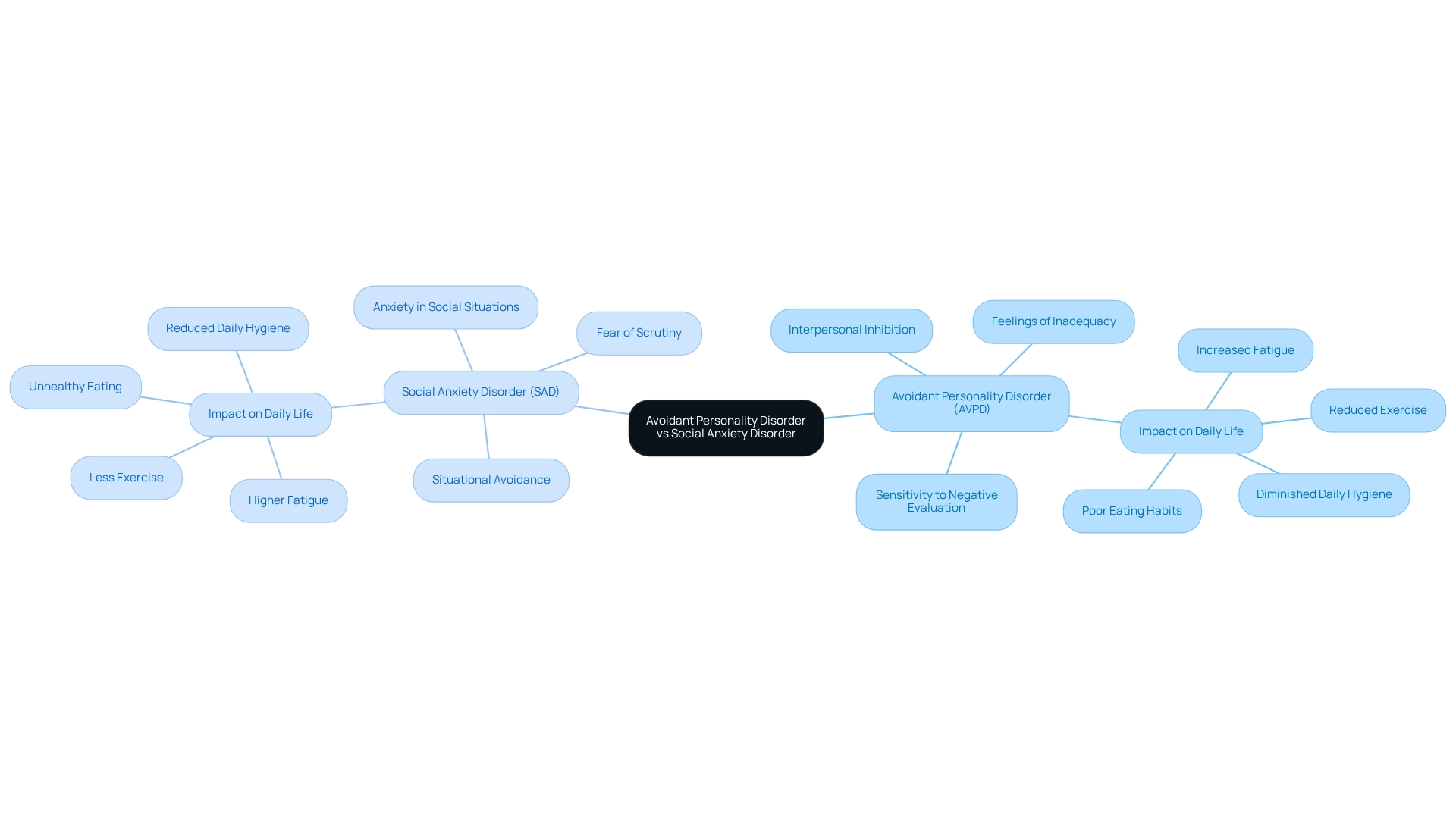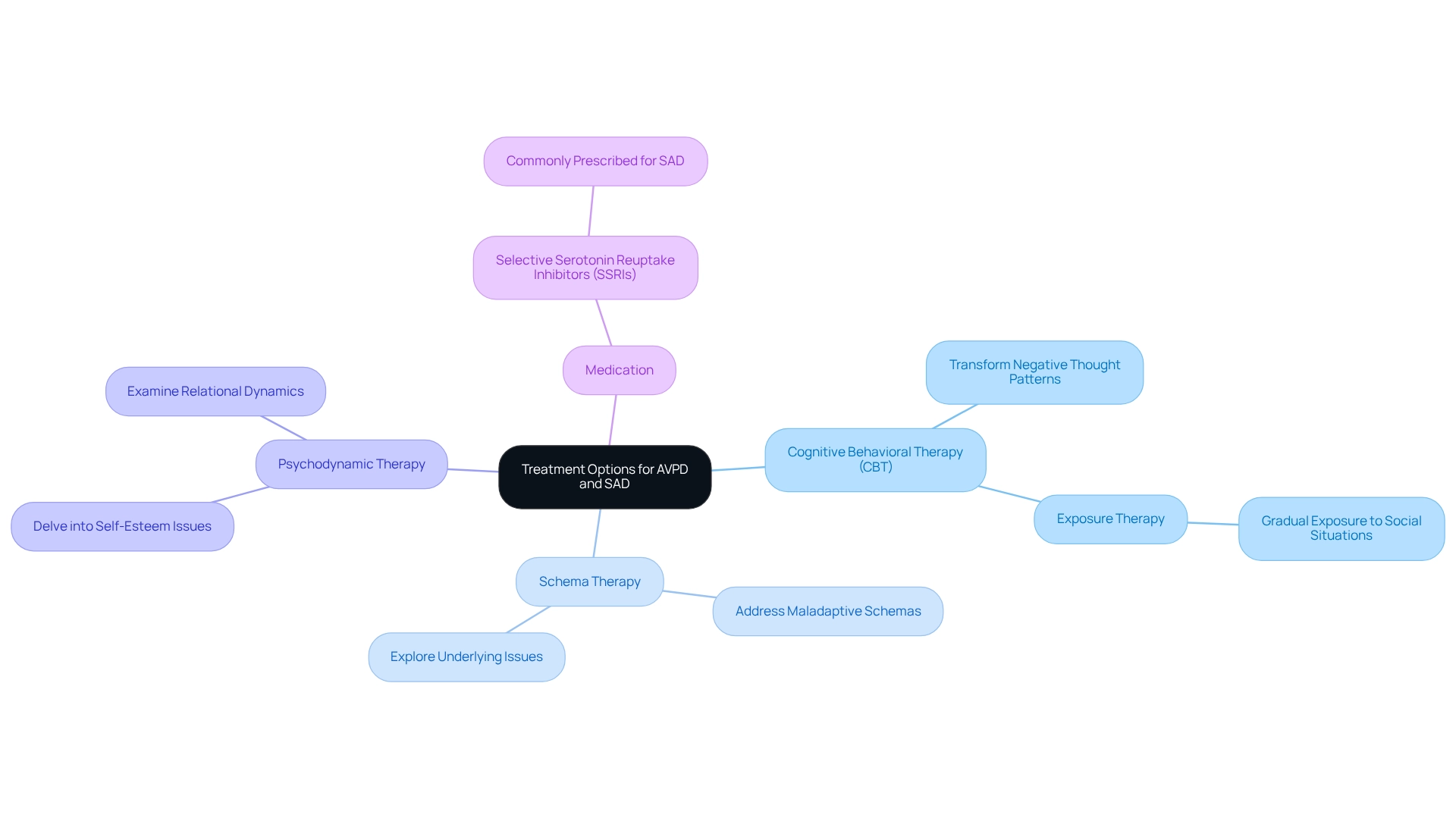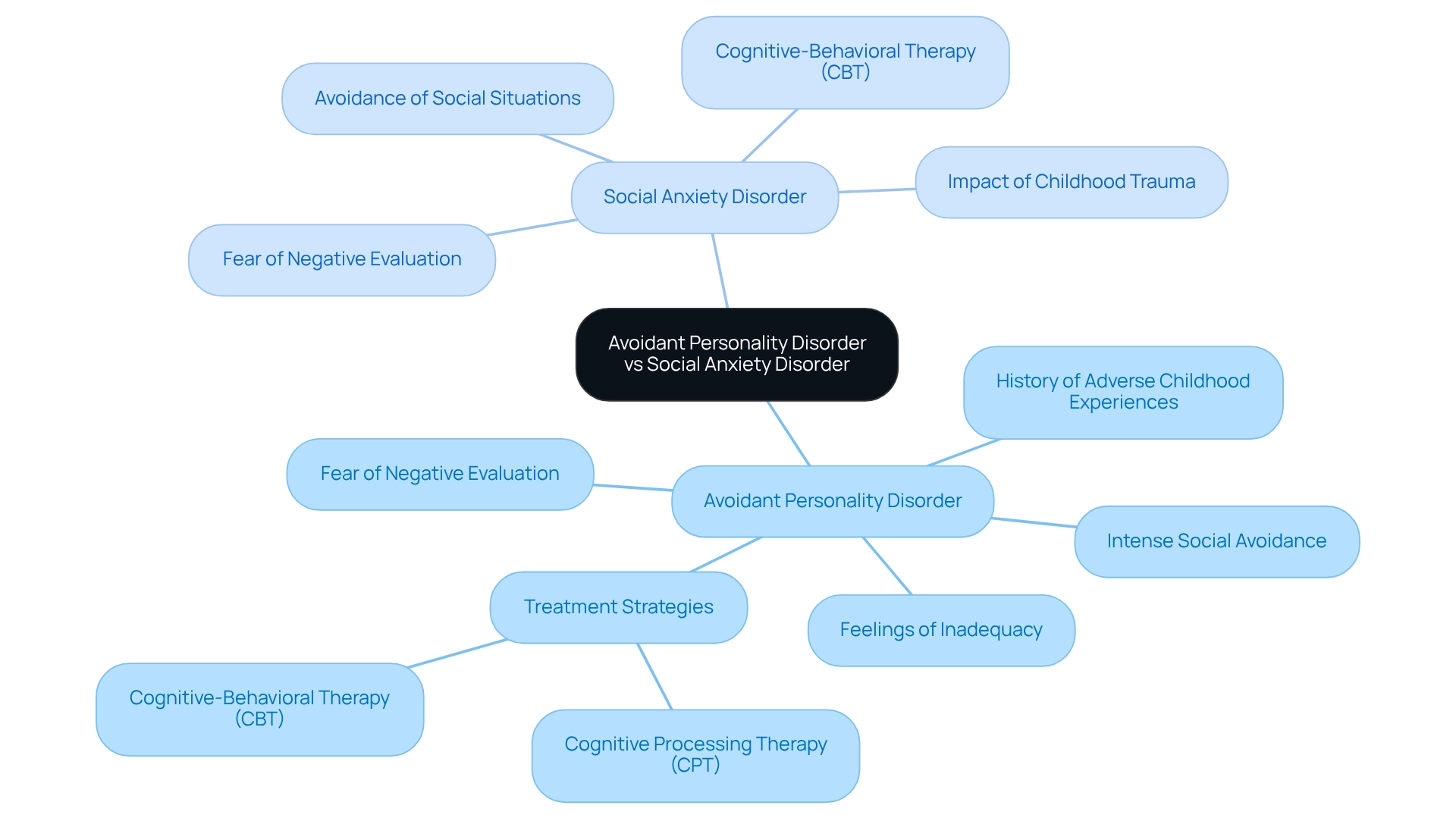Overview
Avoidant Personality Disorder (AVPD) and Social Anxiety Disorder (SAD) differ primarily in the extent of avoidance. AVPD involves a pervasive withdrawal from most social interactions due to an intense fear of rejection, while SAD is characterized by anxiety in specific situations where one might be judged.
Have you ever felt overwhelmed by your past? This article highlights these distinctions through detailed descriptions of symptoms and treatment approaches, emphasizing the importance of tailored interventions that address the unique challenges posed by each disorder.
As we explore this further, it becomes clear that understanding these differences can be a vital step towards healing. Seeking therapy can provide the support needed to navigate these complexities and foster a path to recovery.
Introduction
In a world where social interactions can often feel overwhelming, understanding the subtle differences between Avoidant Personality Disorder (AVPD) and Social Anxiety Disorder (SAD) is crucial. Both conditions share common symptoms, yet they express themselves in unique ways that can significantly impact one’s life. Have you ever felt a deep sense of withdrawal from social situations, fearing judgment from others? This is a hallmark of AVPD, where the fear can be so intense that it leads to pervasive isolation. In contrast, those with SAD may experience anxiety but can still engage socially, albeit with considerable discomfort.
This article aims to gently explore the complexities of these disorders, shedding light on their symptoms, treatment options, and the intricate relationship between them. By highlighting these important distinctions, we hope to empower both individuals and mental health professionals to navigate the path toward effective support and healing. As we delve deeper into this topic, remember that understanding is the first step toward finding the help you deserve.
Define Avoidant Personality Disorder and Social Anxiety Disorder
Avoidant Personality Disorder (AVPD) is characterized by a pervasive tendency for interpersonal inhibition, feelings of inadequacy, and heightened sensitivity to negative evaluation. Individuals with AVPD often find themselves avoiding interpersonal interactions entirely, driven by an intense fear of rejection or criticism. This avoidance can lead to significant challenges in both personal and professional areas of life. In contrast, Social Anxiety Disorder (SAD), commonly known as social phobia, involves a profound fear of situations where one might be scrutinized or judged. While those with SAD may shy away from certain interactions, they typically still engage in some activities, albeit with considerable anxiety. The key distinction between avoidant personality disorder vs social anxiety lies in the extent of avoidance: avoidant personality disorder encompasses a broader spectrum of avoidance in interactions, whereas social anxiety tends to be more situational in nature.
Current statistics reveal that interpersonal anxiety is widespread, with studies indicating a notable increase in symptoms during the pandemic. This highlights the disorder's significant impact on daily functioning. Have you ever noticed how high interpersonal anxiety can affect your daily life? For instance, it has been linked to diminished daily hygiene, reduced exercise, poor eating habits, and increased fatigue. Furthermore, research underscores the importance of support networks in alleviating anxiety, suggesting that maintaining friendships can serve as a protective factor during challenging times.
Understanding the differences in avoidant personality disorder vs social anxiety is essential for effective intervention and support strategies tailored to individuals navigating these disorders. As we explore this further, consider the role of compassionate support in your own journey. Seeking therapy can be a vital step towards healing, offering a safe space to address these feelings and experiences. Remember, you are not alone, and help is available.

Compare Symptoms of Avoidant Personality Disorder and Social Anxiety Disorder
Avoidant Personality Disorder (AvPD) vs Social Anxiety Disorder (SAD) reveals that they share several overlapping symptoms, such as an intense fear of judgment, avoidance of interpersonal situations, and pervasive feelings of inadequacy. However, the way these symptoms manifest can differ significantly when considering avoidant personality disorder vs social anxiety. Individuals with avoidant personality disorder vs social anxiety often display a more pervasive pattern of avoidance, withdrawing from most interactions, even those that do not involve direct scrutiny. This chronic sense of inferiority, combined with extreme sensitivity to criticism and a profound desire for acceptance, frequently leads to isolation. In contrast, those experiencing avoidant personality disorder vs social anxiety may feel anxious primarily in specific situations, like public speaking or meeting new people, yet they can still engage in social activities where they feel more comfortable and secure. Understanding this distinction is essential for effective treatment planning, as it allows mental health professionals to tailor interventions to meet the unique needs of each individual.
At The Emerald Couch, we understand that engaging in therapy is a significant step, especially for trauma survivors. Therapy is not just for those in crisis; it is a compassionate journey that provides a safe, non-judgmental environment for individuals to share their experiences without fear of criticism. Have you ever felt overwhelmed by your past? Recent studies show that untreated AvPD can lead to chronic feelings of isolation, significantly increasing the risk of suicidal ideation and attempts. Furthermore, cultural elements can influence how AvPD symptoms manifest, with individuals in cultures that emphasize extroversion often feeling greater marginalization. This underscores the importance of culturally sensitive care in the diagnosis and treatment of AvPD. By grasping these complexities, individuals can seek assistance and navigate their challenges effectively, paving the way for improved mental health outcomes.
Additionally, avoidant individuals may turn to alcohol or drugs as a form of self-medication, as noted by Zimmerman et al. Regularly feeling high anxiety in social settings may suggest the presence of SAD, prompting individuals to consult a healthcare provider for diagnosis. As we explore this further, remember that seeking help is a courageous step towards healing and well-being.

Examine Treatment Options for Avoidant Personality Disorder and Social Anxiety Disorder
Treatment for avoidant personality disorder vs social anxiety primarily involves psychotherapy, with cognitive-behavioral therapy (CBT) being a cornerstone approach. CBT aims to transform negative thought patterns and behaviors, fostering healthier self-perceptions and interpersonal relationships. Have you ever felt held back by your own thoughts? Additionally, schema therapy and psychodynamic therapy have proven effective, as they delve into the underlying issues of self-esteem and relational dynamics that often accompany AVPD. It is crucial that the provider possesses experience in treating personality disorders to guarantee effective care. At The Emerald Couch, we are committed to ensuring the appropriate therapist match for each person, recognizing that this is essential for your healing journey.
On the other hand, when discussing avoidant personality disorder vs social anxiety, it is often addressed with CBT, which may include exposure therapy. This approach progressively exposes individuals to feared social situations, gradually reducing anxiety over time. Medications, particularly selective serotonin reuptake inhibitors (SSRIs), can also be advantageous for both disorders, although they are more commonly prescribed for SAD. As we explore these options, it's important to remember that the selection of treatment must be customized for each person, taking into account the severity of symptoms and the unique challenges every patient encounters.
At The Emerald Couch, we understand the importance of creating a safe and trusting therapeutic environment. This space is crucial for fostering trust and encouraging active engagement in the therapeutic process. We recognize the stigma that often surrounds therapy and strive to create a compassionate atmosphere where clients feel comfortable sharing their concerns at their own pace. If we are unable to provide the proper therapy or if it is not a good fit, we can refund your session. Research highlights that effective treatment not only addresses symptoms but also empowers individuals to challenge maladaptive schemas that may have dominated their lives. As one participant stated, "In relation to maladaptive schemas… I have started to write up on all my high score schemas and started to think about what created them. Then I discuss with myself whether these schemata should hold any power over me today." This personalized approach is essential for achieving meaningful progress in therapy.

Explore the Relationship Between Avoidant Personality Disorder and Social Anxiety Disorder
The interaction between avoidant personality disorder vs social anxiety holds substantial significance, as both conditions share overlapping symptoms and a high potential for comorbidity. AVPD is often viewed as a more intense form of social anxiety, particularly when comparing avoidant personality disorder vs social anxiety, characterized by extensive avoidance in various social situations. Have you ever felt overwhelmed by your past? Research highlights that individuals with avoidant personality disorder frequently have a history of adverse childhood experiences, which can significantly influence the emergence of both conditions. This connection underscores the importance for clinicians to recognize that addressing one disorder may necessitate a comprehensive approach to the other, especially when both conditions coexist.
At The Emerald Couch, we focus on customized psychotherapy services that address trauma and anxiety disorders, including:
- Social Anxiety Disorder
- Generalized Anxiety Disorder (GAD)
- Obsessive Compulsive Disorder (OCD)
Our personal counseling and telehealth options are designed to create a safe and trusting therapeutic environment, allowing clients to overcome pain and personalize their healing journey. Recent findings indicate that the rates of comorbidity in avoidant personality disorder vs social anxiety are notably high, complicating treatment strategies. Effective interventions must consider the unique challenges posed by each disorder, fostering a deeper understanding of your experiences.
For instance, our method incorporates Cognitive Processing Therapy (CPT), an evidence-based treatment that assists individuals in processing trauma and developing healthier coping mechanisms. A study has highlighted the necessity for further investigation into the connection between childhood experiences—especially neglect and abuse—and the development of social anxiety disorder in adulthood. Such insights are vital for developing targeted therapeutic approaches that resonate with your journey.
Case studies examining avoidant personality disorder vs social anxiety reveal that individuals often grapple with intense feelings of inadequacy and fear of negative evaluation, which can hinder their ability to engage socially. Treatment approaches that integrate cognitive-behavioral therapy (CBT) have shown promise in addressing both disorders simultaneously, allowing clients to confront their fears and develop healthier coping mechanisms. As we explore this further, understanding the nuanced relationship between avoidant personality disorder vs social anxiety allows mental health professionals at The Emerald Couch to better tailor their interventions, ultimately fostering resilience and personal growth in their clients. Together, we can navigate this path toward healing and understanding.

Conclusion
Understanding the distinctions between Avoidant Personality Disorder (AVPD) and Social Anxiety Disorder (SAD) is essential for effective diagnosis and treatment. Have you ever felt overwhelmed by your past? While both conditions share overlapping symptoms such as intense fear of judgment and social avoidance, the extent and nature of these behaviors differ significantly.
- AVPD is marked by a pervasive pattern of withdrawal from social interactions, driven by deep feelings of inadequacy and extreme sensitivity to criticism.
- In contrast, individuals with SAD may avoid specific situations but can still participate in social activities where they feel comfortable.
Effective treatment for both disorders often involves psychotherapy, particularly cognitive-behavioral therapy (CBT), which can transform negative thought patterns and improve self-perceptions.
- For AVPD, therapies that delve into underlying relational dynamics, such as schema therapy, can be particularly beneficial.
- Meanwhile, exposure therapy may play a crucial role in treating SAD, helping individuals gradually face their fears in social contexts.
Recognizing the high comorbidity between AVPD and SAD is vital for mental health professionals, as addressing one disorder often requires a comprehensive approach to the other.
Ultimately, fostering understanding of these disorders empowers individuals to seek appropriate help and encourages mental health professionals to tailor their interventions effectively. By providing compassionate and culturally sensitive care, it is possible to pave the way for healing and personal growth, allowing those affected to reclaim their lives and enhance their social interactions. The journey toward recovery may be challenging, but it is also filled with opportunities for resilience and transformation. Remember, you are not alone on this path; support is available, and taking that first step towards therapy can lead to profound change.
Frequently Asked Questions
What is Avoidant Personality Disorder (AVPD)?
Avoidant Personality Disorder (AVPD) is characterized by a pervasive tendency for interpersonal inhibition, feelings of inadequacy, and heightened sensitivity to negative evaluation. Individuals with AVPD often avoid interpersonal interactions due to an intense fear of rejection or criticism.
How does Avoidant Personality Disorder differ from Social Anxiety Disorder (SAD)?
The key distinction lies in the extent of avoidance: AVPD encompasses a broader spectrum of avoidance in interactions, while Social Anxiety Disorder (SAD) involves a profound fear of specific situations where one might be scrutinized or judged, leading to anxiety but not necessarily complete avoidance.
What are the common symptoms of Social Anxiety Disorder?
Common symptoms of Social Anxiety Disorder include a profound fear of being judged or scrutinized in social situations, leading individuals to avoid certain interactions, although they may still engage in some activities despite experiencing considerable anxiety.
How has the pandemic impacted interpersonal anxiety?
Current statistics indicate that interpersonal anxiety has become widespread, with studies showing a notable increase in symptoms during the pandemic, significantly impacting daily functioning.
What are some effects of high interpersonal anxiety on daily life?
High interpersonal anxiety can lead to diminished daily hygiene, reduced exercise, poor eating habits, and increased fatigue.
What role do support networks play in managing anxiety?
Research highlights the importance of support networks in alleviating anxiety, suggesting that maintaining friendships can serve as a protective factor during challenging times.
Why is it important to understand the differences between AVPD and SAD?
Understanding the differences between Avoidant Personality Disorder and Social Anxiety Disorder is essential for effective intervention and support strategies tailored to individuals navigating these disorders.
What steps can individuals take to address feelings related to these disorders?
Seeking therapy can be a vital step towards healing, offering a safe space to address feelings and experiences associated with AVPD and SAD.




